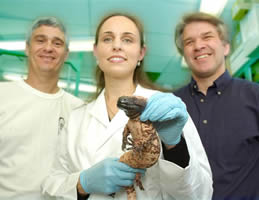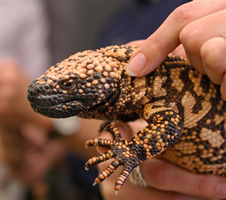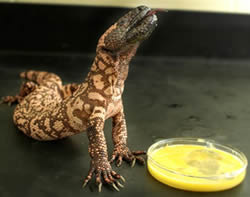Gila Monster Protein Treats Diabetes, Researchers Look for Other Applications
By Chris Bryant

Gila monsters are reclusive, cold-blooded, raw egg-loving lizards whose venomous bites can cause intense pain. Ah, but within that same mouthful of venom-laced saliva is a marvelously therapeutic protein – one which has already been synthesized and used in diabetic drug treatments. And, it’s one which University of Alabama researchers are analyzing in hopes it could later improve the digestive performance of humans compromised by intestinal cancer and/or surgery.
Dr. Stephen Secor, assistant professor of biological sciences, recently hosted 18 Gila monsters (pronounced hee-la) and two Arizona State University scientists within his University of Alabama laboratory. It’s a place more often filled with the Burmese pythons Secor regularly studies rather than the largest lizard species in North America.
“The work in our lab looks at the response of the digestive tract in animals that go through long periods of fasting,” Secor says. “What we’re looking at is simply how the gut responds to long periods of fasting and then the large meal.”
For example, adult pythons may eat only once or twice a year in the wild. During digestion, these snakes, along with Gila monsters and other infrequent digesters, undergo extreme physiological changes. These extensive changes are much easier studied than are any such subtle changes in humans, or other mammals, which are almost always digesting to some extent.
Better understanding the extreme changes in these reptiles could offer researchers clues to the mechanisms of gastric function and the growth of organs in humans.
It was in 1992 than an endocrinologist published a surprising paper outlining the Gila monster’s potentially therapeutic protein.
Secor explains.

“In their venom, which they produce in the glands in the lower part of their jaw, is an interesting protein called exendin-4,” Secor says. “Exendin-4 has been found in mammals, including humans, to actually induce the release of insulin from the pancreas. So, what has become of interest in these lizards is that this is a protein that, if synthesized – as has been done recently – can be used as a drug treatment for type 2 diabetes. It can induce the release of more insulin in patients who are simply having problems producing enough, and releasing enough, insulin from their pancreas to control blood glucose levels.” This synthetic form of the lizard protein is marketed under the name Byetta.
Secor, his postdoctoral researcher Dr. Scott Boback, and two graduate students are working collaboratively with Dr. Dale DeNardo and graduate student Carol Christel, both of Arizona State University, to learn more about Gila monsters.
“They have the lizards, and their interest is in the effect of the exendin-4 on the physiology of the lizard,” Secor says of the partnership. “My interest is in digestive physiology and how these lizards respond to feeding and fasting, so, we’re combining our interests.”
The UA scientist says he’s specifically interested in what role the protein may play in the digestive tract. “It may have some therapeutic effects on increasing the performance of the digestive system. There is also that potential link between what we’re finding and some human application.” Secor says a link could lead, for one example, to better ways of treating the human small intestine when cancer or surgery has damaged it.

While the Gila monster is one of only two venomous lizards in the world, Christel says it’s not considered dangerous to humans.
“The venom itself can be extremely painful,” Christel says. “It’s extremely painful but not fatal. They are not dangerous to people because most often people do not come into contact with them. They are very reclusive, and they will often run away before you even see them.”
Named for the location where it was first found, the Gila River in Arizona, this lizard is native to the Southwestern United States and most commonly found in Arizona and Mexico. Gila monsters are, in many ways, a miniature desert dinosaur, Christel says.
“They have survived, relatively unchanged, for millions of years. It’s a really old species, and part of a bigger family of ancient lizards called the Monstersauria which inhabited the Earth during the age of the dinosaurs. Gila monsters specifically have inhabited the American Southwest for at least 25,000 years.”
Oddly enough, while scientists have learned what this Gila monster’s protein does in humans, its function in the Gila monster is unknown.
“This protein, exendin-4, is only found in this species,” Christel says. “That’s really unusual. Most proteins are universal, in one form or another, within mammals, vertebrates, etc. I’m hoping to find out what it does in Gila monsters – not only because it’s a unique protein – but because it is being used as a drug in today’s market. It might have other effects in the Gila monster that we have yet to discover in humans.”
DeNardo said the collaborative project between Arizona State and UA served both institutions well.
“We wanted to do work for part of this exendin study which incorporates techniques which Dr. Secor has perfected here and has done extensively,” he said. “You can either try to reinvent the wheel in Arizona, or you can come to a lab that’s doing it right, has the equipment, and not only can deal with how to do it when it’s going right, but also trouble-shoot when you have problems. It’s a great collaboration. It really maximizes our effort. We can get more information by working together than we could if we both were working separately.”
Further Reading